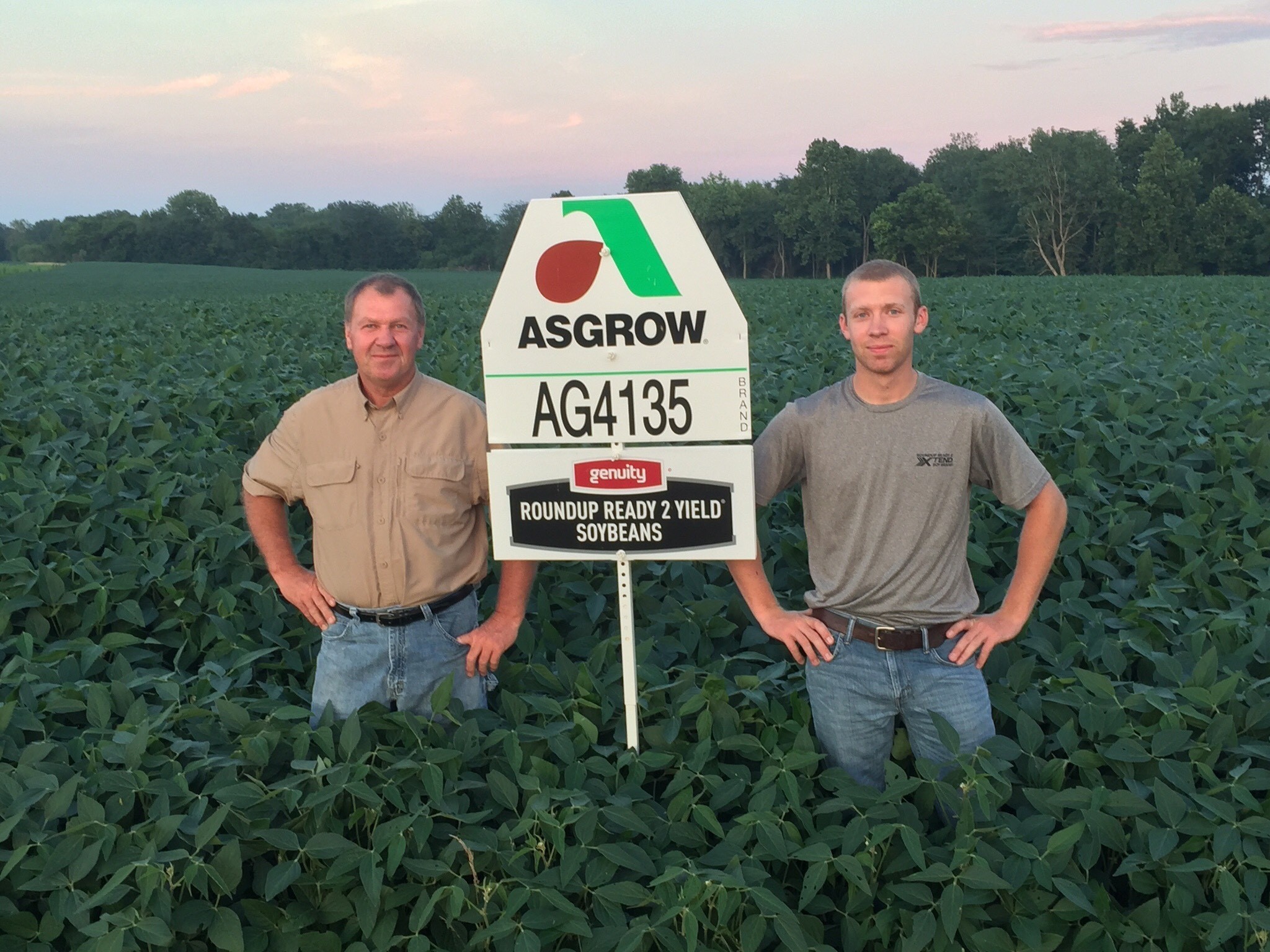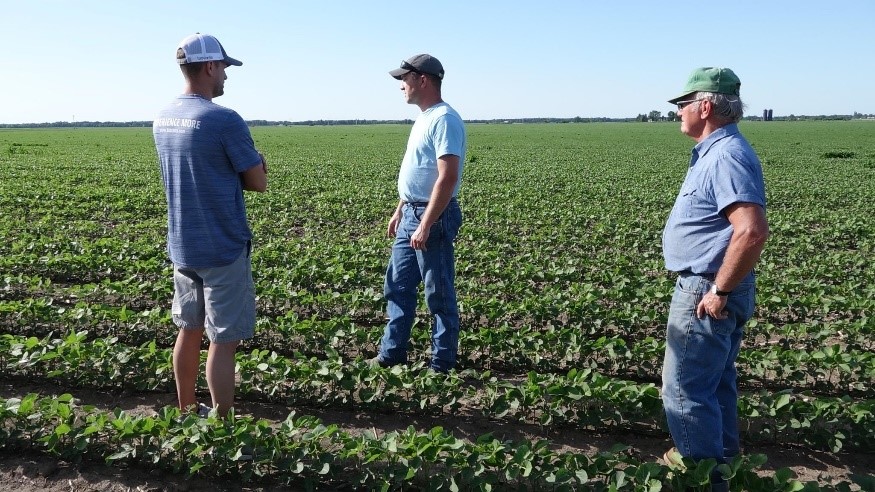The Illinois Soybean Association has been sponsoring the Yield Challenge since 2010. The contest allows growers to compete for the highest soybean yield and greatest yield gain. And many of the entrants are “going for 100” in an attempt to break the 100-bushel ceiling.
Every summer we showcase some of the practices that a few growers are using to reach 100 bushels or record a personal best. It is always exciting to learn what these growers are doing, whom they are getting advice from and their passion for growing high-yield soybeans. There is a lot to learn from their experiences.
Alan Chesnut, Ridge Farm, Illinois: Chesnut is entering the 100-Bushel Challenge for the first time. He said, “I have yields in the 90s, but that 100-bushel target has been elusive. Then last December I decided I was going to break 100 bushels, so I did my homework, talked to people, and created my to-do list, including biologicals and nutrients.” He reached out for advice to Dan Arkels, the 2014 100-Bushel winner and current Biovante representative in Illinois. Under Arkels’ guidance he is making multiple passes across the field from planting to pod fill, applying a range of fertility and biological products.
From left to right: Biovante’s Chris Masters, Alan Chesnut and Alan’s father, Morris Chesnut.
Chesnut is no novice to contests, having entered corn yield contests for many years and knowing what it takes to complete. And he isn’t afraid to make multiple passes through a field to achieve a goal.
Regarding soybeans, he wonders why Illinois producers aren’t creating new yield records. He referenced Kip Cullers (Missouri) and Randy Dowdy (Georgia) who both set soybean records without the benefit of the prairie soils of central Illinois. He said, “In the Midwest we have some of the highest CEC soils and probably some of the best soils in the U.S., but aren’t setting records. I believe our biggest drawback is too much moisture and fields that need to be tiled.”
Realizing that drainage is a major limiting factor, Chesnut chose a field that is system-tiled to remove excess water. And the contest field needed to start with a good pH, base fertility and tilth, which he would supplement with a micronutrient and biological package. After putting a Biovante biological package in the seed trench with liquid fertility in the sidewalls using Precision Planting’s Furrow Jet system, he followed up with a series of post applications, plus weekly scouting and tissue testing.
Arkels added, “Placing fertility and biologicals in the row with the planter is the key in high yield soybeans. You have to concentrate the product application in the row when the taproot system can easily retrieve it.”
Chesnut’s goal is having N, P and K tissue test at excess levels during reproduction and all micronutrients at sufficient levels over the summer by adding a micronutrient and biological package. His strategy was to make a pass at V2, V5, R1, R3 and R4.5. However, the wet weather has been a challenge and he was forced to improvise with a V2 pass, pre-R1 pass and third at late R2/pre-R3. He still plans two more passes. “Like my dad said, ‘You must be willing to farm all summer long and must be looking at the crop all summer.’”
Chesnut has a 50-acre trial block inside a 200-acre commercial field using his conventional practices. “I planted the trial block 11 days later (than the commercial field), but its development quickly caught up. The plants in the plot area are as tall as the rest of the field and for every two nodes in the non-plot field, the plot field has four nodes, double that of the normal field. And in the non-plot field I counted 6 – 7 flowers on a node and in the plot field I counted as many as 14 flowers and pods per node.”
His plan also included spraying a fungicide based on weather risks and insects based on insect outbreaks.
Mark and Aaron Niebrugge, Sigel Illinois: Both Mark and his son Aaron have entered the Yield Challenge since 2014. Mark won his district (Crop District 7) in 2015 with a yield of 87.2 bu/A. However, had he selected another field that he thought looked a bit poorer he might have won the 100-Bushel Challenge. That field clocked in at 112 bu/A when entered in the Asgrow Yield Contest. Mark lamented, “It’s so hard to tell the good fields from the great fields. And flat, black dirt doesn’t always out-yield rolling clays.” Mark’s son Aaron won his district with a yield of 91.9 bu/A in 2016. Across the past three years, the entire farm’s bean yield has averaged between 80 and 90 bu/A. As in the past, they are entering the 100-Bushel Challenge.

Their basic approach is to have a balanced fertility program, fertilize each crop each year, keep soil test levels high and apply P and K based on yield and nutrient removal rates. Their average soil test levels are 100 lbs. phosphate and 400 lbs. potash.
Mark and Aaron consider inoculant especially critical and they use double inoculant with both seed and planter box rhizobia treatments, adding in QuickRoots® for good measure. Aaron said, “About 3 – 4 weeks after emergence we do root digs. We normally count 8 – 10 nodules with a single seed treatment, but when we double inoculate we see as many as 14 nodules.” The Niebrugges know that soybeans require a lot of nitrogen and they believe double inoculating is providing enough. Mark said adding supplement nitrogen isn’t economical and there is too much risk of loss to the environment.
Mark added that this season their soybeans started to flower two weeks before June 20. “So far the beans look excellent with a good stand and very green,” he said. They scout and tissue-test these fields weekly and will make foliar applications of nutrients based on results, adding in a fungicide and insecticide as needed. The Niebrugges’ tips for high-yield beans include:
- Drainage is key to healthy roots and nodulation
- Maintain high potash levels
- Tissue test levels need to be sufficient for all nutrients
- Plant early
- Add a rhizobia inoculant to the seed
- Protect the foliage



